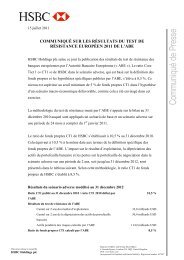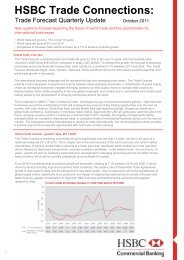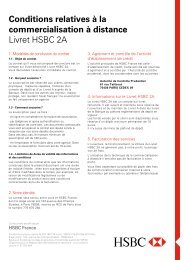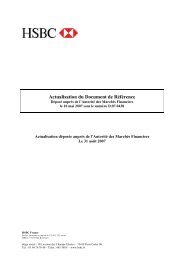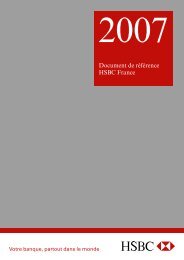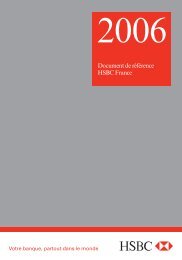HSBC France ⬠20,000,000,000 Euro Medium Term Note Programme
HSBC France ⬠20,000,000,000 Euro Medium Term Note Programme
HSBC France ⬠20,000,000,000 Euro Medium Term Note Programme
You also want an ePaper? Increase the reach of your titles
YUMPU automatically turns print PDFs into web optimized ePapers that Google loves.
Variable Rate <strong>Note</strong>s<strong>Note</strong>s with variable interest rates can be volatile investments. If they are structured to include caps orfloors, or any combination of those features or other similar related features, their market values maybe even more volatile than those for securities that do not include those features.Inverse Floating Rate <strong>Note</strong>sInverse Floating Rate <strong>Note</strong>s have an interest rate equal to a fixed rate minus a rate based upon areference rate. The market values of such <strong>Note</strong>s typically are more volatile than market values of otherconventional floating rate debt securities based on the same reference rate (and with otherwisecomparable terms). Inverse Floating Rate <strong>Note</strong>s are more volatile because an increase in the referencerate not only decreases the interest rate of the <strong>Note</strong>s, but may also reflect an increase in prevailinginterest rates, which further adversely affects the market value of these <strong>Note</strong>s.Fixed/Floating Rate <strong>Note</strong>sFixed/Floating Rate <strong>Note</strong>s may bear interest at a rate that the Issuer may elect to convert from a fixedrate to a floating rate, or from a floating rate to a fixed rate. The Issuer's ability to convert the interestrate will affect the secondary market and the market value of such <strong>Note</strong>s since the Issuer may beexpected to convert the rate when it is likely to produce a lower overall cost of borrowing. If the Issuerconverts from a fixed rate to a floating rate, the spread on the Fixed/Floating Rate <strong>Note</strong>s may be lessfavourable than then prevailing spreads on comparable Floating Rate <strong>Note</strong>s tied to the same referencerate. In addition, the new floating rate at any time may be lower than the rates on other <strong>Note</strong>s. If theIssuer converts from a floating rate to a fixed rate, the fixed rate may be lower than then prevailingrates on its <strong>Note</strong>s.Zero Coupon <strong>Note</strong>s and <strong>Note</strong>s issued at a substantial discount or premiumThe market values of Zero Coupon <strong>Note</strong>s and securities issued at a substantial discount or premiumfrom their principal amount tend to fluctuate more in relation to general changes in interest rates thando prices for conventional interest-bearing securities. Generally, the longer the remaining term of thesecurities, the greater the price volatility as compared to conventional interest-bearing securities withcomparable maturities.The Issuer's obligations under Subordinated <strong>Note</strong>s are subordinatedThe Issuer's obligations under Subordinated <strong>Note</strong>s will be unsecured and subordinated and will rankjunior in priority to the claims of unsubordinated creditors. Although Subordinated <strong>Note</strong>s may pay ahigher rate of interest than comparable <strong>Note</strong>s which are not subordinated, there is a real risk that aninvestor in Subordinated <strong>Note</strong>s will lose all or some of his investment in the event of voluntaryliquidation or judicial liquidation (liquidation judiciaire) of the Issuer.Future capital adequacy requirements for Subordinated <strong>Note</strong>s may disqualify under certaincircumstances the eligibility of some Subordinated <strong>Note</strong>s in the capital of the Issuer.Subordinated <strong>Note</strong>s may be issued for capital adequacy regulatory purposes in accordance with the EUcapital requirements Directives comprising Directive <strong>20</strong>06/48/EC relating to the taking up and pursuitof the business of credit institutions, Directive <strong>20</strong>06/49/EC on the capital adequacy of investment firmsand credit institutions (together, CRD I) and Directive <strong>20</strong>09/111/EC (CRD II) which have beenimplemented in <strong>France</strong> by Règlement no. 90-02 dated 23 February 1990, as amended, of the Comité deRéglementation Bancaire et Financière.35



